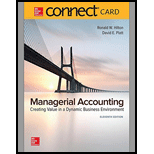
Connect 1-Semester Access Card for Managerial Accounting: Creating Value in a Dynamic Business Environment (NEW!!)
11th Edition
ISBN: 9781259727788
Author: Hilton & Platt
Publisher: MCG
expand_more
expand_more
format_list_bulleted
Question
Chapter 17, Problem 31P
1.
To determine
Define the term joint costs and split-off point.
2.
To determine
Ascertain the dollar values of finished-goods inventories of Company W as on November 30 for VX-4 and HD-10.
3.
To determine
Describe whether the company should sell HD-10 at the split-off point or continue to process it further.
Expert Solution & Answer
Want to see the full answer?
Check out a sample textbook solution
Students have asked these similar questions
Multiple step income statement gross profit?
Provide correct solution and accounting question
Hello tutor give me answer fast plz
Chapter 17 Solutions
Connect 1-Semester Access Card for Managerial Accounting: Creating Value in a Dynamic Business Environment (NEW!!)
Ch. 17 - Prob. 1RQCh. 17 - Prob. 2RQCh. 17 - Should actual or budgeted service department costs...Ch. 17 - Prob. 4RQCh. 17 - Why does dual cost allocation improve the...Ch. 17 - What potential behavioral problem can result when...Ch. 17 - Should actual or budgeted service department costs...Ch. 17 - Explain the difference between two-stage...Ch. 17 - Define the following terms: joint production...Ch. 17 - Prob. 10RQ
Ch. 17 - Describe the relative-sales-value method of joint...Ch. 17 - Define the term net realizable value, and explain...Ch. 17 - Are joint cost allocations useful? If they are,...Ch. 17 - For what purpose should the managerial accountant...Ch. 17 - Prob. 15ECh. 17 - Refer to the data given in the preceding exercise....Ch. 17 - Tuscaloosa National Bank has two service...Ch. 17 - Refer to the data given in the preceding exercise....Ch. 17 - Breakfasttime Cereal Company manufactures two...Ch. 17 - Refer to the data given in the preceding exercise....Ch. 17 - Refer to the data given in Exercise 1720....Ch. 17 - Prob. 23ECh. 17 - Prob. 24PCh. 17 - Prob. 25PCh. 17 - Celestial Artistry Company is developing...Ch. 17 - Snake River Sawmill manufactures two lumber...Ch. 17 - Travelcraft Company manufactures a complete line...Ch. 17 - Biondi Industries is a manufacturer of chemicals...Ch. 17 - Berger Company manufactures products Delta, Kappa,...Ch. 17 - Prob. 31PCh. 17 - Lafayette Company manufactures two products out of...Ch. 17 - Refer to the data given in Problem 1726 for...Ch. 17 - Prob. 34PCh. 17 - Top Quality Fruit Company, based on Oahu, grows,...Ch. 17 - Prob. 36C
Knowledge Booster
Similar questions
- Please show me the correct approach to solving this financial accounting question with proper techniques.arrow_forwardFind the effective yield, to the nearest hundredth of a percent, of an account paying 4.5% compounded quarterly.arrow_forwardProvide correct solution and general accounting questionarrow_forward
arrow_back_ios
SEE MORE QUESTIONS
arrow_forward_ios
Recommended textbooks for you
 Cornerstones of Cost Management (Cornerstones Ser...AccountingISBN:9781305970663Author:Don R. Hansen, Maryanne M. MowenPublisher:Cengage Learning
Cornerstones of Cost Management (Cornerstones Ser...AccountingISBN:9781305970663Author:Don R. Hansen, Maryanne M. MowenPublisher:Cengage Learning Managerial AccountingAccountingISBN:9781337912020Author:Carl Warren, Ph.d. Cma William B. TaylerPublisher:South-Western College Pub
Managerial AccountingAccountingISBN:9781337912020Author:Carl Warren, Ph.d. Cma William B. TaylerPublisher:South-Western College Pub

Cornerstones of Cost Management (Cornerstones Ser...
Accounting
ISBN:9781305970663
Author:Don R. Hansen, Maryanne M. Mowen
Publisher:Cengage Learning

Managerial Accounting
Accounting
ISBN:9781337912020
Author:Carl Warren, Ph.d. Cma William B. Tayler
Publisher:South-Western College Pub